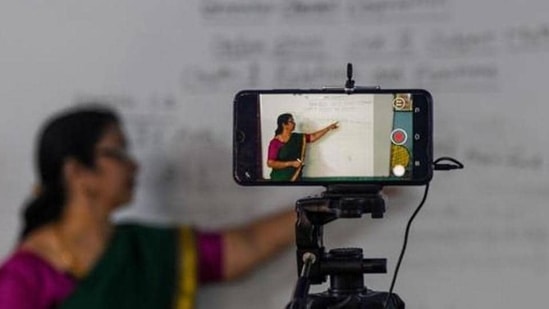How digital interventions can transform education
Technology can solve issues of teacher training, data-based decision-making, remediation and so on. But a one-size-fits-all approach won’t work. Programmes must adapt to local needs
South Asia’s slide deeper into learning poverty — from a pre-pandemic 60% to an estimated 78%, according to Unicef’s 2022 Report: The State of Global Learning Poverty — shows we are now facing a full-blown learning crisis. Moreover, the impact of Covid-19 is expected to drive up this learning poverty i.e., the share of 10-year-olds who cannot read a primary text in lower- and middle-income nations.

What is needed right now is a transformation of existing learning spaces to ensure that quality education is available to all. In these pandemic-hit times, we cannot ignore the necessity of digital infrastructure for education. For example, a Dalberg report on the Covid-19 impact on education suggested that nearly 40% of students in India were unable to access any remote learning during school closures, and while WhatsApp was the most used remote-learning tool (followed by textbooks), digital tools were not as accessible as is often perceived.
On the policy front, one cannot deny there have been attempts. Central and state schemes such as BharatNet and Telangana Fibre Grid have borne some fruit. More than 180,000 gram panchayats have received optical fibre cables and equipment under BharatNet to date. In 2017, the government launched SWAYAM Prabha, a group of 34 direct-to-home channels featuring educational content. It gave students free access to the National Digital Library, and schemes such as DIKSHA provide curriculum access.
Despite all this, access to connectivity remains a critical challenge. As of 2019, only 22% of schools had internet connectivity. Most disproportionately affected are rural areas, where broadband penetration is at 29% compared to 93% in cities. If we want to course correct, connecting every school to the internet needs to be a priority.
What, then, are the gaps that need to be filled? The first thing to ensure is basic Information and Communication Technology — i.e., infrastructure. While BharatNet’s success in kilometres and number of gram panchayats is impressive, it is also important to measure the success in terms of its ability to facilitate basic services such as functional and available connectivity and link them to education and its stakeholders. There is a need to improve the feasibility of private players and community models to utilise this infrastructure. Proper funding incentives and quality assurance mechanisms must be provided for private players to get involved in building and maintaining infrastructure and for last-mile providers to offer services. With these incentives, the government can implement guidelines around last-mile connectivity standards in education institutes.
Delivering connectivity to villages is not enough. Leveraging the networks and influences of local actors such as gram panchayats, self-help groups, and village-level entrepreneurs are crucial for sustaining it. We have several examples of community networks (such as in Karnataka’s Tumkur) that played a crucial role in helping communities access education during the pandemic.
Next, we need to rethink procurement systems. Ensuring the availability of devices and equipment is a start; however, the focus must be on the right kind of equipment. Speed, bandwidth, and reliability of internet connections must be key considerations when acquiring and setting up equipment.
Teachers need to be taken along the journey as well. A report by Unesco shows that teachers continue to struggle when it comes to laptop availability, internet quality, and proficiency in advanced computer skills. Robust and periodic teacher training programmes to help educators understand how to use computers and phones as learning tools are a must.
While traditional in-school models still hold immense value, we also need to start thinking about leveraging connectivity for new, more open models of education. The Digital Empowerment Foundation, for one, has been working on creating digital excellence centres, maker-space type of places where coding, STEM and arts are taught collaboratively and children or adults can walk in, learn, socialise and collaborate. Digital education should also aim to move beyond its basic lessons of accessing resources to training communities in coding.
Technology can also solve issues related to teacher training, data-based decision-making, parental communication, and remediation. However, a one-size-fits-all approach rarely works. Programmes will need local language adaptations, for example. Similarly, there is a need to draw out data that captures the experiences of those belonging to historically marginalised caste groups and gender minorities. For instance, first-generation learners from Scheduled Castes/Tribes or marginalised communities may struggle with the technical skills required to navigate the internet and internet-enabled devices. We know that these divides are real -- prevalent gender norms and scarce household resources may dictate that the male child’s education is prioritised.
We have the tools to enhance learning and usher in a digital democracy. Getting children in India reading can be a gateway to the world of opportunities for their families, communities and the nation, and technology can accelerate them along this path. To ensure equality and social justice, we must close the huge learning gaps created by the pandemic. We must make the most of what we have now to ensure that every child’s right to education does not remain unfulfilled in spirit.
Osama Manzar is founder and director of Digital Empowerment Foundation, a senior Ashoka fellow and advisor for Digital Services at NeGD; Kunal Walia is a partner at Dalberg Advisors and has over a decade of experience in the technology for good space across Asia
The views expressed are personal
Continue reading with HT Premium Subscription




